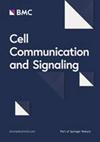推进中风治疗:利用干细胞衍生细胞外囊泡的创新方法
IF 8.2
2区 生物学
Q1 CELL BIOLOGY
引用次数: 0
摘要
脑卒中是导致全球死亡和长期残疾的主要原因,其中急性缺血性脑卒中(AIS)是最常见的亚型。尽管再灌注疗法取得了重大进展,但其有限的时间窗口和相关风险凸显了新型治疗策略的必要性。干细胞衍生的细胞外囊泡(EVs)能够调节中风后的微环境,促进神经保护和神经恢复,因此已成为一种很有前景的治疗方法。这篇综述综述了目前有关干细胞衍生EVs在AIS中治疗潜力的研究,重点是EVs的起源、生物生成、作用机制以及增强其靶向能力和疗效的策略。此外,我们还探讨了创新的联合疗法,并讨论了基于EV的治疗所面临的挑战和前景。我们的研究结果表明,干细胞衍生的EVs在AIS中表现出多种治疗效果,如促进神经元存活、减轻神经炎症、保护血脑屏障、增强血管生成和神经再生。为了提高EVs的疗效,人们开发了各种策略,包括靶向修饰和货物修饰。将 EVs 与再灌注疗法、干细胞移植、纳米药物和肠道微生物组调节等其他治疗方法相结合,有望改善中风预后。然而,EVs 的异质性、EVs 生产和质量控制标准化方案的需求等挑战仍有待解决。干细胞衍生的 EV 是治疗 AIS 的新途径,有可能解决目前治疗方法的局限性。要优化基于 EV 的疗法并将其优势转化为临床实践,还需要进一步的研究,重点是确保安全性、克服监管障碍以及提高 EV 向靶组织递送的特异性和有效性。本文章由计算机程序翻译,如有差异,请以英文原文为准。
Advancing stroke therapy: innovative approaches with stem cell-derived extracellular vesicles
Stroke is a leading cause of mortality and long-term disability globally, with acute ischemic stroke (AIS) being the most common subtype. Despite significant advances in reperfusion therapies, their limited time window and associated risks underscore the necessity for novel treatment strategies. Stem cell-derived extracellular vesicles (EVs) have emerged as a promising therapeutic approach due to their ability to modulate the post-stroke microenvironment and facilitate neuroprotection and neurorestoration. This review synthesizes current research on the therapeutic potential of stem cell-derived EVs in AIS, focusing on their origin, biogenesis, mechanisms of action, and strategies for enhancing their targeting capacity and therapeutic efficacy. Additionally, we explore innovative combination therapies and discuss both the challenges and prospects of EV-based treatments. Our findings reveal that stem cell-derived EVs exhibit diverse therapeutic effects in AIS, such as promoting neuronal survival, diminishing neuroinflammation, protecting the blood-brain barrier, and enhancing angiogenesis and neurogenesis. Various strategies, including targeting modifications and cargo modifications, have been developed to improve the efficacy of EVs. Combining EVs with other treatments, such as reperfusion therapy, stem cell transplantation, nanomedicine, and gut microbiome modulation, holds great promise for improving stroke outcomes. However, challenges such as the heterogeneity of EVs and the need for standardized protocols for EV production and quality control remain to be addressed. Stem cell-derived EVs represent a novel therapeutic avenue for AIS, offering the potential to address the limitations of current treatments. Further research is needed to optimize EV-based therapies and translate their benefits to clinical practice, with an emphasis on ensuring safety, overcoming regulatory hurdles, and enhancing the specificity and efficacy of EV delivery to target tissues.
求助全文
通过发布文献求助,成功后即可免费获取论文全文。
去求助
来源期刊

Cell Communication and Signaling
CELL BIOLOGY-
CiteScore
11.00
自引率
0.00%
发文量
180
期刊介绍:
Cell Communication and Signaling (CCS) is a peer-reviewed, open-access scientific journal that focuses on cellular signaling pathways in both normal and pathological conditions. It publishes original research, reviews, and commentaries, welcoming studies that utilize molecular, morphological, biochemical, structural, and cell biology approaches. CCS also encourages interdisciplinary work and innovative models, including in silico, in vitro, and in vivo approaches, to facilitate investigations of cell signaling pathways, networks, and behavior.
Starting from January 2019, CCS is proud to announce its affiliation with the International Cell Death Society. The journal now encourages submissions covering all aspects of cell death, including apoptotic and non-apoptotic mechanisms, cell death in model systems, autophagy, clearance of dying cells, and the immunological and pathological consequences of dying cells in the tissue microenvironment.
 求助内容:
求助内容: 应助结果提醒方式:
应助结果提醒方式:


